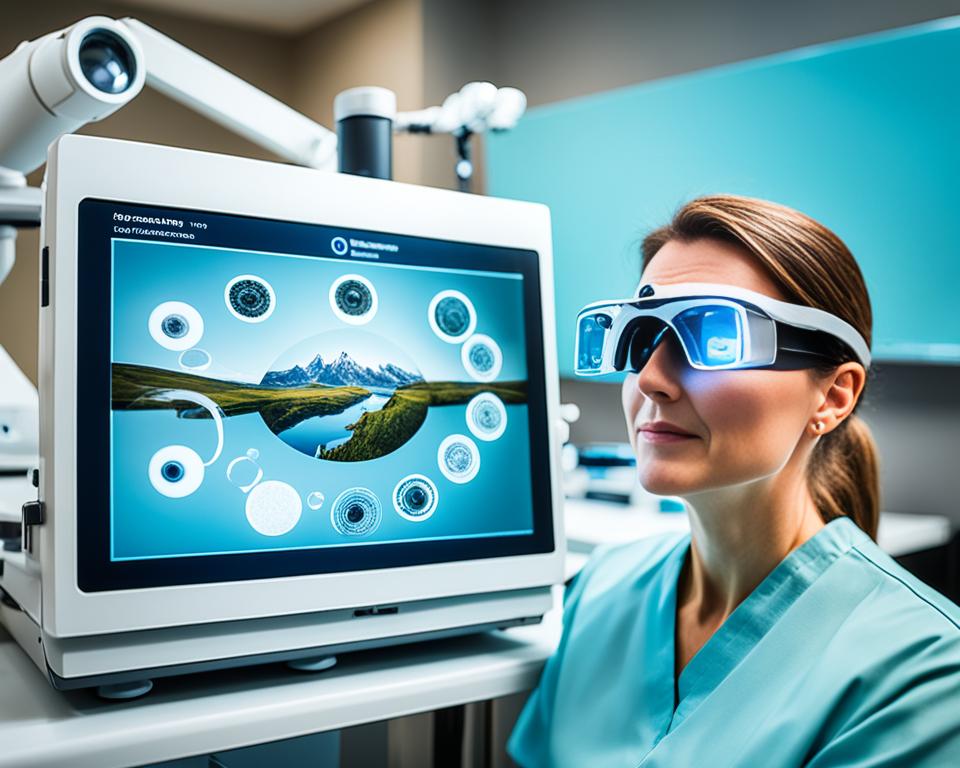LASIK is a top choice for those with nearsightedness (myopia). It’s a refractive surgery that uses a laser. This laser reshapes the cornea, letting you see clearly without glasses or contacts. For many, it’s a lasting fix for vision issues.
Read interesting things at : warlockgroup
Key Takeaways
- LASIK is a popular and effective laser vision correction procedure for nearsightedness (myopia).
- The procedure reshapes the cornea to improve focusing power and eliminate the need for glasses or contacts.
- LASIK has become a trusted and widely-adopted solution for permanent vision correction.
- Wavefront-guided LASIK and bladeless LASIK offer advanced technologies for customized corneal reshaping and improved outcomes.
- Careful patient selection and working with an experienced LASIK surgeon are crucial for achieving optimal results.
What is LASIK?
LASIK is a kind of refractive surgery. It uses a laser to reshape the cornea, the front part of your eye. It fixes issues like nearsightedness, farsightedness, and astigmatism. These are problems with how the eye focuses light.
With LASIK, the surgery is done on the cornea itself. It doesn’t need to be taken off. The term “in situ” means just that. It’s a quick way to improve your vision.
Understanding Laser-Assisted In Situ Keratomileusis
In LASIK, a surgeon first makes a tiny flap in the cornea. They use a special laser or a microkeratome for this. Then, they gently open this flap and use an excimer laser on the cornea.
This laser removes a tiny bit of tissue from the cornea. It changes the cornea’s shape. By doing this, the eye can focus light better. This can mean no more glasses or contacts.
The Evolution of Refractive Surgery
LASIK surgery has gotten a lot better over the years. It now uses better lasers and methods. This makes LASIK both safe and effective for a lot of people. You could get clear vision without help from glasses or contacts.
As LASIK has improved, so have the results and the time it takes to get better. It’s a big step forward in how we fix our eyes. And the technology just keeps getting better.
Nearsightedness and Its Impact
Nearsightedness, also known as myopia, makes faraway things look blurry, but close-up things clear. It’s because the eye can’t focus light right. This happens when the cornea is too curved or the eyeball is too long. Myopia affects daily life, making things like driving, reading, and sports harder.
Causes and Symptoms of Myopia
Myopia comes from the eye not focusing light properly, leading to blurry distance vision. The cornea’s extra curve or the long eyeball causes this. People with myopia might squint, feel eye strain, and get headaches. This is common when looking at faraway things.
Limitations of Traditional Vision Correction Methods
Glasses and contact lenses are often used to correct myopia, but they don’t fix it for good. They help for a while, but the eye problem remains. Many folks must keep using these aids throughout their lives. But Lasik for nearsightedness can change this by correcting the cornea. This will reduce or even eliminate the need for glasses or contacts.
LASIK for Nearsightedness
LASIK is an excellent way to fix nearsightedness, also called myopia. A surgeon uses a special laser during LASIK. This laser gently changes the shape of the cornea by removing tiny bits of tissue. This helps light focus right on the retina, making vision clear and sharp.
How LASIK Corrects Myopia
During LASIK, the doctor reshapes the cornea, which is the eye’s clear front. They use an advanced laser to do this. By taking away some corneal tissue with the laser, they can make the cornea flatter or steeper. This allows light to focus correctly on the retina, meaning your vision becomes clear.
Advantages of LASIK over Other Treatments
LASIK has many benefits over other ways to fix vision. First, its results are permanent. This means you might not need glasses or contacts anymore. Plus, getting better usually happens quickly. LASIK can also give you better vision quality than glasses or contacts ever could.
Wavefront-Guided LASIK
Wavefront-guided LASIK is a modern type of laser vision correction. It uses high-tech tools to map out the eye very precisely. This map is called wavefront analysis. It helps surgeons spot and fix even tiny flaws in the cornea. As a result, each patient gets a special treatment plan.
Customized Corneal Reshaping
The wavefront-guided LASIK method uses this advanced mapping tech. It makes your vision better than standard LASIK. By pinpointing and treating unique issues in each person’s cornea, patients see clearer. This makes the corneal reshaping more personal and successful, offering outstanding results.
People who choose wavefront-guided LASIK often find their vision gets very clear. Many say they can see better at night. They also notice less glare and halos. This type of laser vision correction is at the forefront of refractive surgery. It gives each patient a treatment tailored just for them.
Bladeless LASIK
Bladeless LASIK offers a more advanced way to do LASIK surgery. It uses a special laser to do the first step differently. This laser makes a detailed eye flap without a blade, making the surgery safer and more exact. So, this method lowers the chance of issues and makes the whole process more reliable.
Precision and Accuracy with Femtosecond Lasers
The big deal with bladeless LASIK is the femtosecond laser it uses. This tool gives off very quick pulses of laser light. It means creating the eye flap is done very accurately. Since there’s no blade, problems like a wrong flap shape or uneven changes to the eye are less likely. This makes the surgery better for the patient.
If you go for bladeless LASIK, you might find the recovery easier and see better than with traditional LASIK. The femtosecond laser does things in a very precise way. This leads to a faster healing time and less chance of problems after the surgery.
Candidacy for LASIK
Not everyone can get LASIK, a common procedure for improving nearsightedness with lasers. A surgeon looks at many things to see if someone is ready for it. They check the person’s age, their current glasses or contacts prescription, the thickness of their cornea, and if their eyes are healthy overall.
Factors Determining Eligibility
If you want LASIK for nearsightedness, you have to fit certain criteria. The surgeon checks if your vision has stayed the same for a year. They also look at your cornea’s thickness and shape since this surgery shapes the cornea.
Other key factors for LASIK suitability include age and eye health. If you have dry eyes, specific corneal problems, or too high expectations, LASIK might not be right for you.
Pre-operative Evaluations
Before LASIK, you’ll have a big check-up. This includes tests like looking at the shape of your cornea, how light goes through your eye, and how big your pupil gets. The doctor will also make sure your eyes are healthy and warn you about any risks.
Doing these tests helps the surgeon make the best plan for you. It lowers the chances of problems and makes sure you’re a good fit for LASIK.

The LASIK Procedure
The LASIK procedure lasts less than 30 minutes. It uses high-tech laser tools. First, the doctor makes a thin flap on the cornea. Next, a laser shapes the cornea with guidance from a computer. This matches the eye’s unique shape.
Step-by-Step Guide
In LASIK, surgeons carefully follow a prescribed sequence for safe and accurate treatment. They start by making a flap on the cornea with a special tool. This flap is lifted to access the cornea underneath.
Then, an excimer laser sculpts the cornea. It removes tiny bits of tissue in a precise manner. The surgeon might flatten or curve the cornea as needed. Once done, they put the flap back into place to act as a natural cover for quick healing.
Advanced Technologies Used
LASIK is at the forefront of laser tech and eye surgery. The excimer laser offers custom treatments for every patient’s eye shape. It’s accurate and effective.
Advanced software and analysis tools let the surgeon plan with great detail. This planning stage is key for a successful and low-risk LASIK surgery. It improves the chances of the patient enjoying sharp and steady vision.
Recovery and Aftercare
After LASIK, recovery is usually quick and comfy. You might feel a bit of discomfort, like eyeball dryness or light sensitivity. This usually goes away in a day or two. During this time, it’s good to rest, use special eye drops, and stay away from things that could bother your eyes.
What to Expect After LASIK
Getting your eyes fixed by laser eye surgery takes a bit of time to fully heal. Some days or even weeks might pass before your eyes are back to normal. Right after the surgery, you might have some issues, like trouble seeing at night or some blurriness. But, this gets better as your eyes adjust and heal.
Lifestyle Adjustments
As your eyes get better over the next few weeks, you can start doing your regular activities. Yet, it’s key to stick to what your doctor tells you. This means no swimming, rough sports, and keeping away from dusty places. These things could slow down your healing.
Potential Risks and Side Effects
Even though LASIK is safe, it has some risks. These include dry eyes, glare, and rare infections. Patients need to know about these and work with their eye doctor. This helps reduce any problems.
Understanding Potential Complications
Lasik risks can lead to dry eyes or seeing blurry. Sometimes, patients might have more problems like infections. While these are rare, it’s important for patients to ask questions. They should talk to their doctor about any laser eye surgery side effects they notice.
Managing Expectations
Patients should know what to expect from LASIK. This means understanding the surgery and possible problems. If they follow their doctor’s advice closely, things should go well. But, if they see any issues with their eyes, they must tell their doctor right away. Their doctor can then help or change the plan.

Choosing the Right LASIK Surgeon
Finding the right LASIK surgeon is key for the best results and less risk. Patients should pick someone with a board certification and lots of experience. Also, choose a surgery center known for the latest tech in eye laser surgery and top safety and quality.
Qualifications and Experience
When you look for a LASIK surgeon, look for one with a good history. Find someone who’s done thousands of LASIK surgeries. They should be certified by an ophthalmology board. This shows they’re skilled and can give the best care.
Facility and Equipment Standards
The quality of the surgery center and its tools are important too. Pick a place that uses the newest laser tech for more precise surgery. Look for a center known for its safe practices and great patient outcomes.
LASIK for Nearsightedness
LASIK is now a well-known method for fixing nearsightedness permanently. Many people have questions about this procedure, how well it works, and what recovery looks like. Answering these common questions helps patients better understand LASIK. This understanding helps them decide if it’s the right choice for them.
Addressing Frequently Asked Questions
Patients often ask how good LASIK is for nearsightedness. Studies show LASIK is very effective, often leading to better than 20/20 vision. Most people see great results after the surgery.
Another common worry is about the recovery. Although people recover at different rates, most find it quick and easy. You might have some light sensitivity and dry eyes at first. Yet, these issues usually go away as your eyes heal.
Patient Testimonials and Success Stories
Listening to success stories from LASIK patients can be very reassuring. Many people who had LASIK talk about how it changed their lives for the better. They often mention how happy they are with their vision now.
“I was tired of glasses and contacts. Since having LASIK, I’ve been able to do so much without worrying about my eyes,” says Sarah, who’s 35.
Michael added, “The procedure was easy, and the outcome is amazing. My confidence is much higher without having to wear glasses or contacts.”
These stories are powerful examples of LASIK’s impact. It can truly change someone’s daily life for the better by providing a lasting solution to nearsightedness.
Cost Considerations
The price of LASIK surgery can change based on a few key things. The surgeon’s skill level, the kind of laser used, how hard the surgery is, and where the surgery happens all play a part. Patients should look into different LASIK providers to find the best value.
Factors Affecting LASIK Pricing
On average, LASIK costs between $3,000 and $4,000 per eye. This includes expert surgeons, the latest laser tech like wavefront-guided systems, and where the clinic is located. Remember, LASIK is a long-lasting way to better your life by improving your vision.
Financing Options
Many LASIK clinics offer ways to make paying easier. These options can be payment plans, special medical credit cards, or help from outside financing companies. Talking to the surgeon’s team about financing can help you figure out the best way to pay LASIK.
